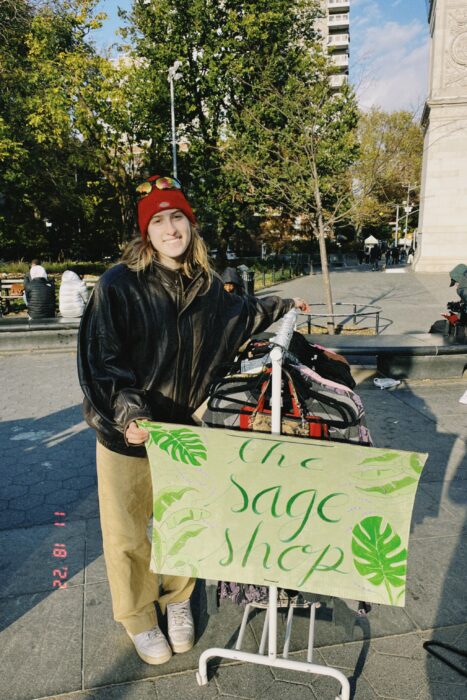Sage Klein-Being Sustainably Fashionable
Sage Klein is not your average college student. Her weekends are not filled with football games and tailgates, but rather, an effort to make a difference for the environment through selling secondhand clothing.
Hailing from the Tahoe area in Northern California, Klein has been exposed to sustainability from a young age, “It is a really environmentally cognizant area.” she continued, “Growing up, my grandma was really into thrifting, same with my mom, so I grew up with it being a part of my life.”
Klein moved to New York City a few months ago to attend the Fashion Institute of Technology, where she studies sustainable fashion. She was inspired to learn more about the secondhand clothing world once she realized not a lot of people were educated on the topic, “It has been such a big part of my life, and I was kind of surprised that less people know about it and that it was sort of stigmatized. I really want people to get into it; that’s why I am studying how to really push secondhand because the clothing industry is so wasteful, and there are so many clothes out there. It is just crazy how many items there already are that people would think are super cool.”
Sage, herself, has been wearing only secondhand clothing for the past year and a half now, “I realized there is so much stuff that gets put into big thrift and secondhand stores that basically get sent to the trash if people don’t buy it. There are so many things out there that cost so much less and are so much more affordable.” She was wearing a unique and effortlessly cool brown leather jacket that showed her individuality through its style. I pointed to her jacket and asked if she had thrifted it, “Yeah, this leather jacket is a great example. That’s what I love about secondhand stores. It is so one of a kind, and that is just so awesome to me.”
Klein talked about how the fast fashion industry, which consists of several mainstream clothing brands, is especially harmful. She said the internet plays a big part in how the waste within the industry has progressed, “People are posting all of these hauls on the internet from retail places which encourage people to mass consume, but those items really don’t last and end just end up in a landfill.” I started to think how much I have consumed from fast fashion throughout the years without really knowing the effects on the environment and how happy I am that people like Sage exist to school me on it.
With this passion for promoting sustainable fashion, every weekend in Washington Square Park, Klein sets up a rack of clothing she has thrifted herself with a sign reading, “The Sage Shop.” As I looked through her selected pieces, I noticed how each item was creatively picked and idiosyncratic, “I tend to find things and try to just put them back in circulation,” she said, “I think a lot of people don’t really like the act of going to the thrift store because it is like a big hunt, but I am one of those people that really does enjoy it. So I feel like if I can make it more accessible and eliminate the part that some people don’t like, that’s what I want to do.”
Sage had made some online sales when she was back in California, but says she prefers to sell her items in person in New York, “I feel like I can make it accessible to people here in New York because there are so many people everywhere. The most rewarding part is just to see people buy something from me that they would’ve gone and bought from some fast fashion company, and then I am just making a little bit of difference which is great.”
Sage said her grandest wish and vision for the future of fashion is that all brands start using secondhand, “I want it to become the norm, like brands can still be creative with it, but it would just be less mass producing.”
It’ll be people like Sage that are working to make an impact daily in their communities that bring that grand vision one step closer to reality. Thanks for your efforts, Sage.
You can visit The Sage Shop on most Fridays and weekends in Washington Square Park.

